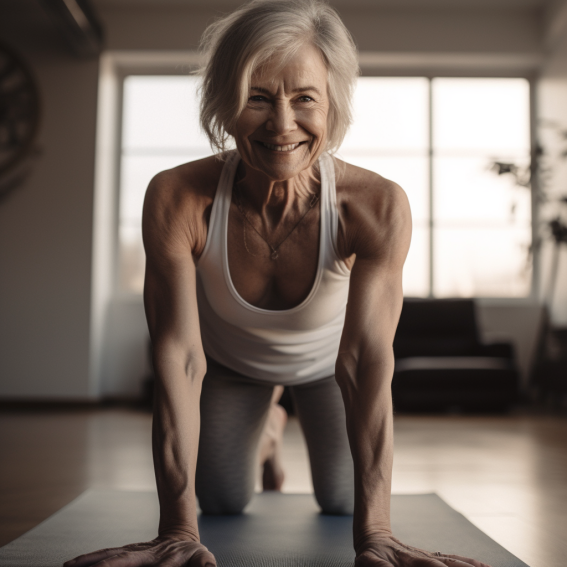This article explores at-home exercises for individuals seeking to improve their bone health and manage osteoporosis. It highlights the importance of regular physical activity and emphasizes the benefits of specific exercises for strengthening bones and reducing the risks associated with osteoporosis.
Introduction: Why is Exercise Important for Osteoporosis?
Osteoporosis is a common condition that affects the bones, causing them to become brittle and weak. It occurs when the body loses too much bone or is unable to make enough bone to keep up with natural bone loss. A lack of physical activity and a sedentary lifestyle are major risk factors for osteoporosis. However, regular exercise can help improve bone density and strength, reduce the risk of falls and fractures, and support overall bone health.
- Building Strong Bones:
The Role of Exercise:
Weight-bearing and resistance exercises are particularly effective in building strong bones. These types of exercises involve placing stress on the bones, which stimulates the body to produce new bone tissue. Examples of weight-bearing exercises include walking, jogging, dancing, and jumping rope, while resistance exercises include weightlifting and bodyweight exercises such as push-ups and squats. These exercises help to build muscle mass, which in turn supports the bones and helps to prevent fractures. - Reducing the Risk of Falls:
Falls are a significant risk factor for fractures in people with osteoporosis. As such, exercises that improve balance, coordination, and flexibility are also important for preventing falls. Tai Chi, yoga, and Pilates are all effective forms of exercise that focus on these areas. These exercises can also help to improve posture and reduce the risk of back pain, which is a common problem for people with osteoporosis.

An elderly woman lifting hand weights while seated in a chair, demonstrating the importance of exercise for osteoporosis.
Can Weight-Bearing Exercises Help Strengthen Bones?
Weight-bearing exercises are an effective way to strengthen bones and promote bone health. These exercises involve placing stress on the bones, which stimulates the body to produce new bone tissue. The stress caused by weight-bearing exercises is essential for maintaining and improving bone density, which is particularly important for people with osteoporosis.
Examples of weight-bearing exercises include walking, jogging, dancing, and jumping rope. These exercises are easy to incorporate into daily life and can be done almost anywhere. Even low-impact weight-bearing exercises, such as walking, have been shown to have significant benefits for bone health.
Resistance exercises, such as weightlifting, are also effective in strengthening bones. These exercises involve using weights or resistance bands to challenge the muscles and bones. Resistance exercises can help build muscle mass, which in turn supports the bones and helps prevent fractures.
Studies have shown that weight-bearing and resistance exercises can improve bone density and reduce the risk of fractures in people with osteoporosis. In one study, postmenopausal women who participated in a weight-bearing exercise program for six months showed significant improvements in bone density and strength compared to women who did not exercise.
"Balance is Key": Focusing on Stability and Coordination
In addition to weight-bearing and resistance exercises, focusing on stability and coordination is also important for improving bone health. These types of exercises help to improve balance and reduce the risk of falls, which is a major concern for people with osteoporosis.
Balance exercises can be as simple as standing on one foot or walking heel-to-toe. These exercises help to improve proprioception, or the body's awareness of its position in space. Improving proprioception can help prevent falls and reduce the risk of fractures.
Coordination exercises, such as tai chi or yoga, can also be beneficial for people with osteoporosis. These exercises help to improve balance, flexibility, and strength, which can all contribute to better bone health. Additionally, these exercises can help reduce stress and improve overall well-being.
Incorporating balance and coordination exercises into your routine can be easy and fun. Many community centers and gyms offer classes in tai chi and yoga, and there are also many online resources available. By focusing on stability and coordination, you can improve your overall physical function and reduce the risk of falls and fractures.

A woman practicing a balance exercise, such as standing on one leg or using a stability ball, to enhance coordination and stability.
Conclusion: Taking Charge of Your Bone Health
In conclusion, osteoporosis is a serious condition that can have a significant impact on a person's quality of life. However, the good news is that there are many things you can do to improve your bone health and reduce your risk of fractures. By incorporating weight-bearing and resistance exercises into your routine, focusing on stability and coordination, and making healthy lifestyle choices, you can take charge of your bone health and prevent the progression of osteoporosis.
It's important to remember that improving bone health is a lifelong process. Even if you've already been diagnosed with osteoporosis, it's never too late to start making positive changes. By working with your healthcare provider and following a personalized plan, you can improve your bone density, reduce your risk of fractures, and maintain your independence and mobility.
At-home osteoporosis exercises can be a great way to improve your bone health and reduce your risk of fractures. However, it's important to start slowly and gradually increase the intensity and duration of your workouts. Always listen to your body, and don't hesitate to seek guidance from a healthcare professional if you have any concerns.
At-Home Osteoporosis Exercises for Improved Bone Health:
| Exercise | Benefits | Frequency | Equipment Needed |
|---|---|---|---|
| Walking | Strengthens bones and improves balance | At least 5 days a week | None |
| Yoga | Improve posture and increase flexibility | At least 2-3 times a week | Yoga mat |
| Weightlifting | Strengthens bones and increases muscle mass | 2-3 times a week | Dumbbells or weight machines |
| Stair Climbing | Strengthens lower body and improves balance | At least 4 days a week | Stairs or stair-climbing machine |
Incorporating these at-home exercises into a daily routine can significantly improve bone health and reduce the risk of fractures associated with osteoporosis. Consult with a healthcare professional to create a personalized exercise plan and monitor progress.

